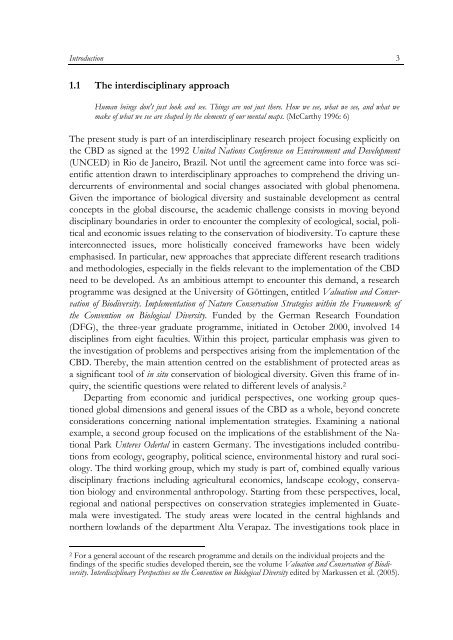The cultural context of biodiversity conservation - Oapen
The cultural context of biodiversity conservation - Oapen
The cultural context of biodiversity conservation - Oapen
Create successful ePaper yourself
Turn your PDF publications into a flip-book with our unique Google optimized e-Paper software.
Introduction<br />
1.1 <strong>The</strong> interdisciplinary approach<br />
Human beings don't just look and see. Things are not just there. How we see, what we see, and what we<br />
make <strong>of</strong> what we see are shaped by the elements <strong>of</strong> our mental maps. (McCarthy 1996: 6)<br />
<strong>The</strong> present study is part <strong>of</strong> an interdisciplinary research project focusing explicitly on<br />
the CBD as signed at the 1992 United Nations Conference on Environment and Development<br />
(UNCED) in Rio de Janeiro, Brazil. Not until the agreement came into force was scientific<br />
attention drawn to interdisciplinary approaches to comprehend the driving undercurrents<br />
<strong>of</strong> environmental and social changes associated with global phenomena.<br />
Given the importance <strong>of</strong> biological diversity and sustainable development as central<br />
concepts in the global discourse, the academic challenge consists in moving beyond<br />
disciplinary boundaries in order to encounter the complexity <strong>of</strong> ecological, social, political<br />
and economic issues relating to the <strong>conservation</strong> <strong>of</strong> <strong>biodiversity</strong>. To capture these<br />
interconnected issues, more holistically conceived frameworks have been widely<br />
emphasised. In particular, new approaches that appreciate different research traditions<br />
and methodologies, especially in the fields relevant to the implementation <strong>of</strong> the CBD<br />
need to be developed. As an ambitious attempt to encounter this demand, a research<br />
programme was designed at the University <strong>of</strong> Göttingen, entitled Valuation and Conservation<br />
<strong>of</strong> Biodiversity. Implementation <strong>of</strong> Nature Conservation Strategies within the Framework <strong>of</strong><br />
the Convention on Biological Diversity. Funded by the German Research Foundation<br />
(DFG), the three-year graduate programme, initiated in October 2000, involved 14<br />
disciplines from eight faculties. Within this project, particular emphasis was given to<br />
the investigation <strong>of</strong> problems and perspectives arising from the implementation <strong>of</strong> the<br />
CBD. <strong>The</strong>reby, the main attention centred on the establishment <strong>of</strong> protected areas as<br />
a significant tool <strong>of</strong> in situ <strong>conservation</strong> <strong>of</strong> biological diversity. Given this frame <strong>of</strong> inquiry,<br />
the scientific questions were related to different levels <strong>of</strong> analysis. 2<br />
Departing from economic and juridical perspectives, one working group questioned<br />
global dimensions and general issues <strong>of</strong> the CBD as a whole, beyond concrete<br />
considerations concerning national implementation strategies. Examining a national<br />
example, a second group focused on the implications <strong>of</strong> the establishment <strong>of</strong> the National<br />
Park Unteres Odertal in eastern Germany. <strong>The</strong> investigations included contributions<br />
from ecology, geography, political science, environmental history and rural sociology.<br />
<strong>The</strong> third working group, which my study is part <strong>of</strong>, combined equally various<br />
disciplinary fractions including agri<strong>cultural</strong> economics, landscape ecology, <strong>conservation</strong><br />
biology and environmental anthropology. Starting from these perspectives, local,<br />
regional and national perspectives on <strong>conservation</strong> strategies implemented in Guatemala<br />
were investigated. <strong>The</strong> study areas were located in the central highlands and<br />
northern lowlands <strong>of</strong> the department Alta Verapaz. <strong>The</strong> investigations took place in<br />
2 For a general account <strong>of</strong> the research programme and details on the individual projects and the<br />
findings <strong>of</strong> the specific studies developed therein, see the volume Valuation and Conservation <strong>of</strong> Biodiversity.<br />
Interdisciplinary Perspectives on the Convention on Biological Diversity edited by Markussen et al. (2005).<br />
3

















